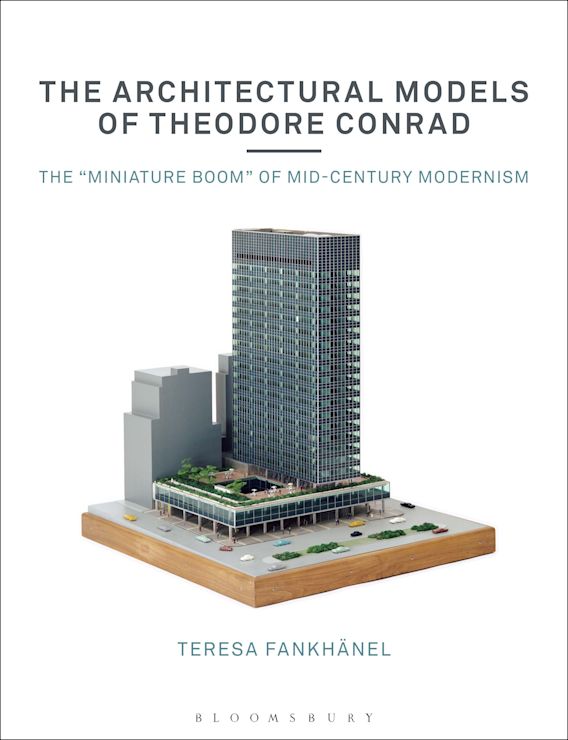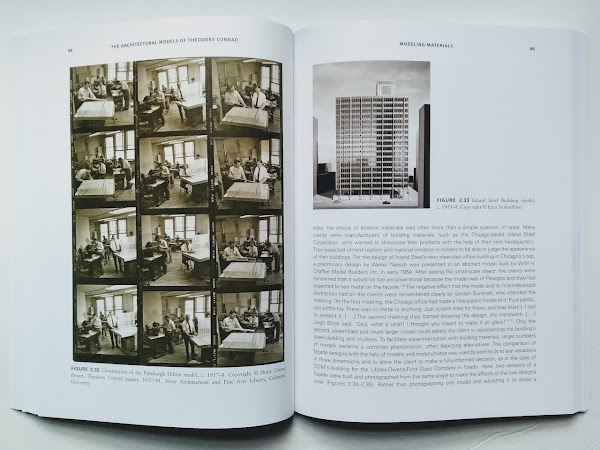The Architectural Models of Theodore Conrad
The Architectural Models of Theodore Conrad: The "Miniature Boom" of Mid-Century Modernismby Teresa FankhänelBloomsbury Visual Arts, July 2021Paperback | 7 x 9 inches | 224 pages | 150 illustrations | English | ISBN: 9781350152830 | $37.95PUBLISHER'S DESCRIPTION:Based on the recent discovery of his fully-preserved private archive-models, photos, letters, business files, and drawings-this book tells the story of Theodore Conrad (1910-1994), the most prominent and prolific architectural model-maker of the 20th century.Conrad's innovative models were instrumental in the design and realization of many icons of American Modernism-from the Rockefeller Center to Lever House and the Seagram Building. He revolutionized the production of architectural models and became a model-making entrepreneur in his own right. Yet, despite his success and the well-known buildings he helped to create, until now little has been known about Conrad's work and his impact on 20th century architectural history.With exclusive access to Conrad's archive, as well as that of model photographer Louis Checkman-both of which have lain undiscovered in private storage for decades-this book examines Conrad's work and legacy, accompanied by case studies of his major commissions and full-color photographs of his works. Set against the backdrop of the surge in model-making in the 1950s and 1960s-which Jane Jacobs called “The Miniature Boom”-it explores how Conrad's models prompt broader scholarly questions about the nature of authorship in architecture, the importance of craftsmanship, and about the translation of architectural ideas between different media. The book ultimately presents an alternative history of American modern architecture, highlighting the often-overlooked influence of architectural models and their makers.Teresa Fankhänel is a curator at the Architekturmuseum der TUM in Munich, Germany.REFERRAL LINKS: dDAB COMMENTARY:A search for "Theodore Conrad" on the Museum of Modern Art website yields five works in MoMA's collection but, oddly, not a single artist with that name. Clicking on one of the works, the Lever House in New York City, indicates that Skidmore, Owings & Merrill and Gordon Bunshaft are the "artists" and Conrad is the "model maker." That Conrad is not considered the artist of an object he literally made is a situation that is probably not limited to MoMA, though it does seem to be fairly common in the realm of architectural models. Hugh Ferris, the architectural illustrator who rendered buildings designed by other architects last century, is considered an artist by MoMA, though this could be attributed to his famous zoning studies — art in their own right — that famously depicted angular skyscrapers in Manhattan. An equal to Ferris in the world of architectural models, in terms of being viewed as an artist, elicits crickets in my head. Of anyone, Conrad, who I was not familiar with before receiving this book from Bloomsbury, would be the closest to such a person, given his fame last century, the quality of his models, and the fact some of those models are part of the most important architecture and design collection in the United States.Conrad's model of Lever House mentioned above graces the cover of Teresa Fankhänel's The Architectural Models of Theodore Conrad, which sounds like a biography of Conrad. Although the model maker's name is in the title, the subtitle indicates that the book, which was developed from Fankhänel's 2016 doctoral dissertation at the University of Zurich, is also about the phenomenon of architectural model-making in the middle of last century. The term "miniature boom," as it was coined by Jane Jacobs in an article in Architectural Forum in 1958, indicates that architects soliciting model makers for high quality scale models happened in the 1950s and 60s, coinciding with the prevalence of International Style modernism in New York and other cities before tapering off in the 70s. Among other things, Fankhänel's book of architectural history illuminates how the boom actually had its start decades earlier, particularly in the 1930s, when Conrad set up his own model shop in Jersey City. A couple of Conrad's models in the MoMA collection actually date from this decade: MoMA's own 1939 building, designed by Philip L. Goodwin and Edward Durell Stone; and Le Corbusier's Villa Savoye, which Conrad made in model form for MoMA's inaugural architecture exhibition, in 1932. Both models are discussed at different points in Fankhänel's book.The Architectural Models of Theodore Conrad is structured into five thematic chapters: "Architectural Model Making as a Profession," which traces the profession of architectural model making from the 1930s to the 50s, with a focus on Conrad's workshop; "Modeling Materials," on cardboard, wood, plasticine, aluminum, acrylic, and other materials used in making scale models; "Model Drawings," a short chapter on the media by which an architect's drawings are translated into mo

Bloomsbury Visual Arts, July 2021
Paperback | 7 x 9 inches | 224 pages | 150 illustrations | English | ISBN: 9781350152830 | $37.95
PUBLISHER'S DESCRIPTION:
REFERRAL LINKS:
SPREADS:










